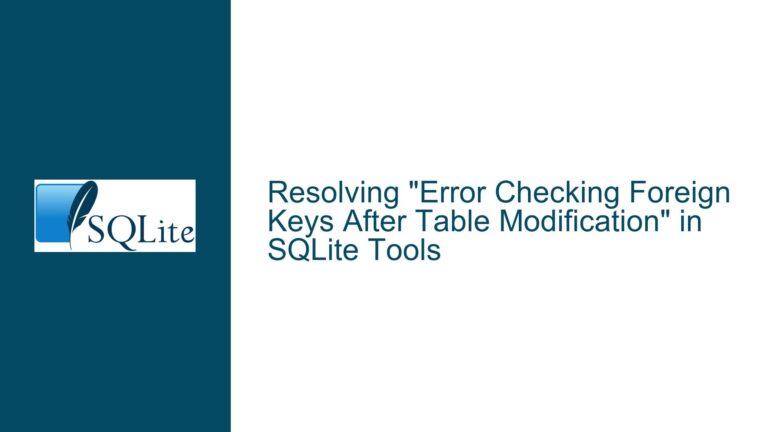Foreign Key Constraints on SQLite Virtual Tables: Limitations and Workarounds
Understanding SQLite Virtual Tables and Foreign Key Enforcement Boundaries
The interaction between SQLite’s foreign key constraint system and virtual tables represents a critical junction of database design principles. This issue arises when developers attempt to enforce referential integrity between a base table column (e.g., unit_id in an item table) and a virtual table containing reference data (e.g., a constants table storing measurement units). The core conflict stems from SQLite’s architectural decision to treat virtual tables as external data sources outside its transactional control framework. Unlike conventional tables where SQLite maintains full authority over data modifications, virtual tables act as interfaces to content managed by other systems – whether in-memory structures, application-layer code, or remote databases. This fundamental distinction creates an irreconcilable gap in constraint enforcement mechanisms, as foreign key validation requires persistent coordination between parent and child tables that virtual tables cannot guarantee.
Architectural Constraints Preventing Foreign Keys on Virtual Tables
1. Transactional Isolation Incompatibility
SQLite enforces foreign key constraints through its transaction manager, which tracks all data modifications within an atomic operation. When a base table references another base table via foreign key, SQLite’s engine can:
- Validate constraint compliance at COMMIT time
- Maintain row-level locks during write operations
- Roll back entire transactions if constraint violations occur
- Track cascading updates/deletes through the WAL (Write-Ahead Log)
Virtual tables implement their own data storage mechanisms through module methods like xBestIndex, xFilter, and xNext. These methods often bypass SQLite’s native transaction system. For example:
- An FTS5 virtual table for full-text search might index external documents
- A CSV virtual table could read live data from changing files
- A custom virtual table might proxy requests to a web API
When a virtual table serves as the parent in a foreign key relationship, SQLite cannot:
- Guarantee the existence of referenced rows during concurrent writes
- Prevent phantom reads (new rows appearing mid-transaction)
- Enforce row exclusivity locks during constraint checks
- Detect external modifications after initial validation
2. Data Volatility and Ephemeral States
Consider a constants virtual table dynamically generating IDs for measurement units from an enum in application code. At time T1:
INSERT INTO item (qty, unit_id) VALUES (5, 2); -- unit_id=2 exists
At time T2, the application redeploys with a modified enum:
// Original: enum { KG=1, LITRE=2, METER=3 };
// Modified: enum { LITRE=1, KG=2, METER=3 };
The virtual table now reports unit_id=2 as KG instead of LITRE. All existing item.unit_id=2 rows now reference a semantically different unit without any SQL-level constraint violation. This demonstrates how foreign keys on virtual tables could silently corrupt data relationships when the external data model evolves independently of the database schema.
3. Indexing and Query Optimization Barriers
Foreign key enforcement relies on efficient lookups in the parent table’s referenced column. Base tables automatically maintain indexes for primary keys, enabling O(1) lookups during constraint validation. Virtual tables may:
- Lack persistent indexes (e.g., in-memory virtual tables)
- Use approximate indexes (common in full-text search modules)
- Delegate indexing to external systems with different consistency models
When attempting to validate item.unit_id against a constants.id virtual column, SQLite would need to execute a full scan of the virtual table for each insert/update – a performance death sentence for large datasets. The query planner cannot assume the existence of deterministic indexing strategies for virtual tables, making constraint enforcement prohibitively expensive.
Implementing Referential Integrity Without Native Foreign Keys
Solution 1: Materialized Reference Tables with Synchronization Triggers
Convert the virtual constants table into a base table with application-managed content:
-- Schema definition
CREATE TABLE constants (
id INTEGER PRIMARY KEY,
code TEXT NOT NULL UNIQUE
);
CREATE TABLE item (
qty INTEGER,
unit_id INTEGER REFERENCES constants(id)
);
-- Application sync logic (pseudo-code)
function sync_constants() {
const enumUnits = get_units_from_codebase();
db.execute('BEGIN IMMEDIATE');
db.execute('DELETE FROM constants');
for (const [id, code] of enumUnits) {
db.execute('INSERT INTO constants (id, code) VALUES (?, ?)', [id, code]);
}
db.execute('COMMIT');
}
Advantages:
- Enables native foreign key constraints
- Atomic updates via transaction blocks
- Compatible with all SQLite tooling
Trade-offs:
- Requires manual synchronization with codebase enums
- Introduces slight storage overhead
- Needs version tracking if enums change frequently
Automation Strategy:
Implement trigger-based version checks using a schema_versions table:
CREATE TABLE schema_versions (
component TEXT PRIMARY KEY,
version INTEGER NOT NULL
);
CREATE TRIGGER validate_constants_version
BEFORE INSERT ON constants
BEGIN
SELECT CASE
WHEN (SELECT version FROM schema_versions WHERE component='units')
!= current_application_version()
THEN RAISE(ABORT, 'Constants out of sync with application version')
END;
END;
Solution 2: Hybrid Materialized Views with INSTEAD OF Triggers
For cases requiring live data from virtual tables, create a materialized cache that refreshes on demand:
-- Base table acting as a cache
CREATE TABLE constants_cache (
id INTEGER PRIMARY KEY,
code TEXT NOT NULL,
valid_until DATETIME
);
-- View that combines cache and virtual table
CREATE VIEW constants AS
SELECT id, code FROM constants_cache
WHERE valid_until > CURRENT_TIMESTAMP
UNION ALL
SELECT id, code FROM virtual_constants
WHERE NOT EXISTS (
SELECT 1 FROM constants_cache
WHERE id = virtual_constants.id
);
-- Trigger to handle inserts via the view
CREATE TRIGGER constants_insert INSTEAD OF INSERT ON constants
BEGIN
INSERT INTO constants_cache (id, code, valid_until)
VALUES (NEW.id, NEW.code, '9999-12-31 23:59:59');
END;
Constraint Enforcement:
Create a foreign key to the materialized cache instead of the virtual table:
CREATE TABLE item (
qty INTEGER,
unit_id INTEGER REFERENCES constants_cache(id)
);
Synchronization Mechanism:
Periodically purge stale cache entries and refresh from the virtual table:
CREATE TRIGGER refresh_constants_cache
AFTER INSERT ON item
FOR EACH ROW
WHEN NOT EXISTS (SELECT 1 FROM constants_cache WHERE id = NEW.unit_id)
BEGIN
DELETE FROM constants_cache WHERE valid_until < CURRENT_TIMESTAMP;
INSERT INTO constants_cache (id, code, valid_until)
SELECT id, code, DATETIME('now', '+1 hour')
FROM virtual_constants
WHERE id = NEW.unit_id;
END;
Solution 3: Application-Layer Constraint Enforcement with SQLite Hooks
Implement foreign key checks in application code using SQLite’s update hooks:
// SQLite C API example
void unit_id_update_handler(
void *context,
int op,
char const *db_name,
char const *table_name,
sqlite3_int64 rowid
) {
if (op == SQLITE_INSERT && strcmp(table_name, "item") == 0) {
sqlite3 *db = (sqlite3 *)context;
sqlite3_stmt *stmt;
sqlite3_prepare_v2(db,
"SELECT unit_id FROM item WHERE rowid = ?", -1, &stmt, NULL);
sqlite3_bind_int64(stmt, 1, rowid);
if (sqlite3_step(stmt) == SQLITE_ROW) {
int unit_id = sqlite3_column_int(stmt, 0);
// Check against virtual table
sqlite3_stmt *check;
sqlite3_prepare_v2(db,
"SELECT 1 FROM virtual_constants WHERE id = ?", -1, &check, NULL);
sqlite3_bind_int(check, 1, unit_id);
if (sqlite3_step(check) != SQLITE_ROW) {
sqlite3_finalize(check);
sqlite3_finalize(stmt);
sqlite3_exec(db, "ROLLBACK", NULL, NULL, NULL);
exit(1); // Handle error
}
sqlite3_finalize(check);
}
sqlite3_finalize(stmt);
}
}
// Registration during database initialization
sqlite3_update_hook(db, unit_id_update_handler, db);
Optimization Considerations:
- Cache valid
unit_idvalues in memory - Batch check multiple pending inserts
- Use savepoints for nested transaction handling
Solution 4: Shadow Tables with Trigger-Based Validation
Create a base table mirror of the virtual table’s key structure, maintained via triggers:
CREATE TABLE virtual_constants_shadow (
id INTEGER PRIMARY KEY
);
-- Trigger on virtual table read to populate shadow
CREATE TRIGGER capture_virtual_constants
AFTER SELECT ON virtual_constants
BEGIN
INSERT OR IGNORE INTO virtual_constants_shadow (id)
VALUES (NEW.id);
END;
-- Foreign key to shadow table
CREATE TABLE item (
qty INTEGER,
unit_id INTEGER REFERENCES virtual_constants_shadow(id)
);
-- Validation trigger for item inserts
CREATE TRIGGER validate_unit_id
BEFORE INSERT ON item
FOR EACH ROW
BEGIN
SELECT RAISE(ABORT, 'Invalid unit_id')
WHERE NOT EXISTS (
SELECT 1 FROM virtual_constants_shadow
WHERE id = NEW.unit_id
);
END;
Maintenance Strategy:
Periodically prune the shadow table of stale IDs no longer present in the virtual table:
CREATE TRIGGER clean_shadow_table
AFTER COMMIT
BEGIN
DELETE FROM virtual_constants_shadow
WHERE id NOT IN (SELECT id FROM virtual_constants);
END;
Comparative Analysis of Solutions:
| Solution | Data Freshness | Performance | Complexity | ACID Compliance |
|---|---|---|---|---|
| Materialized Table | Low | High | Medium | Full |
| Hybrid View | Medium | Medium | High | Partial |
| Application Hooks | High | Variable | High | Depends on Code |
| Shadow Tables | Medium | Medium | High | Partial |
Implementation Recommendations:
- Static Reference Data: Use materialized tables with CI/CD pipeline integration to sync enum changes.
- Dynamic Reference Data: Implement hybrid views with TTL-based caching for optimal freshness/performance balance.
- High-Write Environments: Combine shadow tables with periodic cleanup jobs to minimize trigger overhead.
- Distributed Systems: Employ application-layer checks with distributed locking mechanisms for cross-database consistency.
Advanced Topic: Custom Virtual Table Modules with Constraint Awareness
For scenarios requiring both virtual table flexibility and constraint enforcement, develop a custom virtual table module that implements foreign key validation internally:
// SQLite Virtual Table Module skeleton
static int xBestIndex(
sqlite3_vtab *pVTab,
sqlite3_index_info *pInfo
) {
// Inspect constraint clauses for foreign key checks
for (int i = 0; i < pInfo->nConstraint; i++) {
if (pInfo->aConstraint[i].iColumn == ID_COLUMN &&
pInfo->aConstraint[i].op == SQLITE_INDEX_CONSTRAINT_EQ) {
pInfo->aConstraintUsage[i].argvIndex = 1;
pInfo->aConstraintUsage[i].omit = 1;
pInfo->estimatedCost = 1.0;
return SQLITE_OK;
}
}
return SQLITE_ERROR;
}
static int xFilter(
sqlite3_vtab_cursor *pCursor,
int idxNum, const char *idxStr,
int argc, sqlite3_value **argv
) {
CustomCursor *pCur = (CustomCursor *)pCursor;
if (idxNum == 1) {
int target_id = sqlite3_value_int(argv[0]);
// Validate against application's enum store
if (!is_valid_unit_id(target_id)) {
return SQLITE_CONSTRAINT_FOREIGNKEY;
}
}
// Rest of filter implementation
}
This approach moves constraint validation into the virtual table’s query processing layer, enabling early rejection of invalid foreign key values during statement preparation rather than at execution time.
Migration Strategy for Existing Systems:
- Audit all foreign key relationships involving virtual tables
- Categorize reference data as static, dynamic, or external
- Implement appropriate solutions from the above matrix
- Use SQLite’s
PRAGMA foreign_key_checkduring migration validation - Update ER diagrams and schema documentation to reflect constraint boundaries
Performance Optimization Techniques:
- Partial Indexes: For hybrid solutions, create filtered indexes on materialized portions
CREATE INDEX idx_constants_cache_active ON constants_cache(id) WHERE valid_until > CURRENT_TIMESTAMP; - Write-Ahead Log Modes: Use
PRAGMA journal_mode=WALto improve concurrent write performance in materialized tables - Statistical Feedback: Analyze query plans with
PRAGMA optimizeto maintain index efficiency - Batch Validation: For application-layer checks, validate multiple foreign keys in single queries
SELECT COUNT(*) FROM (SELECT DISTINCT unit_id FROM item) WHERE unit_id NOT IN (SELECT id FROM constants);
Testing and Validation Protocol:
- Unit Tests: Verify foreign key rejection for invalid IDs across all access paths
- Concurrency Tests: Use multiple threads/processes to simulate race conditions
- Crash Recovery Tests: Validate constraint integrity after power failures or SIGKILL
- Benchmarking: Measure throughput with tools like
sqlite3_analyzerand custom load generators - Schema Diffing: Use
sqldiffutility to ensure structural consistency across environments
Conclusion:
While SQLite’s architecture intentionally omits foreign key support for virtual tables due to fundamental consistency guarantees, numerous robust workarounds exist. The optimal solution depends on specific application requirements around data freshness, write volume, and system complexity. By combining SQLite’s native constraint mechanisms with careful application design, developers can maintain referential integrity even when integrating with external data sources through virtual tables.






